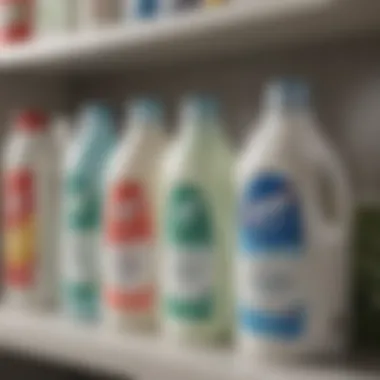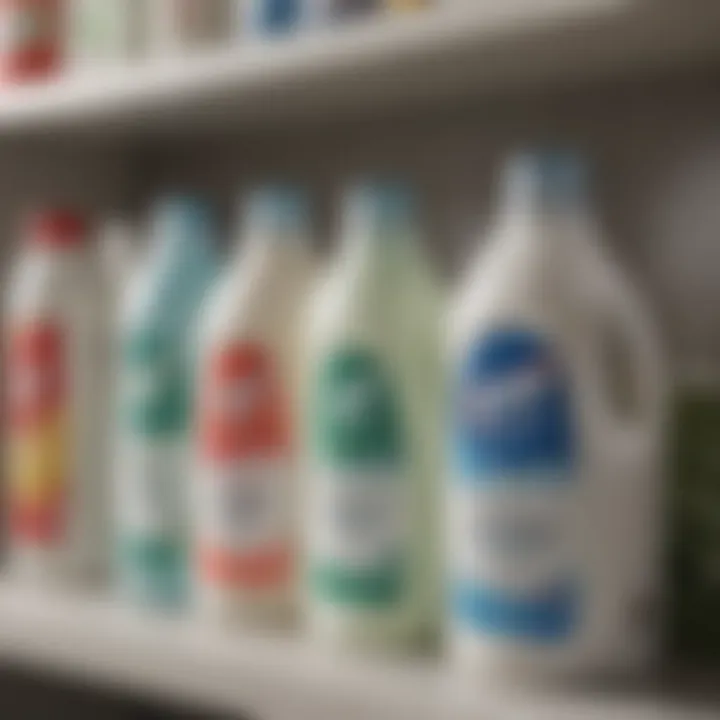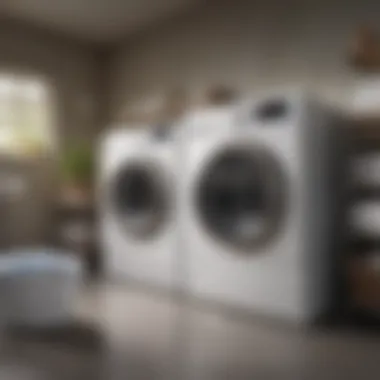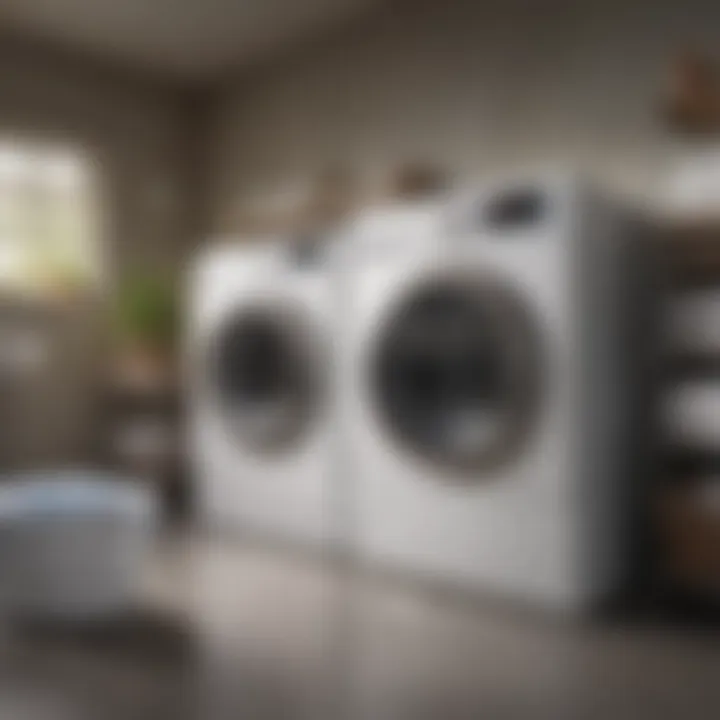High-Efficiency Laundry Detergents: A Complete Guide


Intro
In the domestic world, laundry can seem like an ongoing saga, often complicated by the sheer variety of detergents available. As eco-conscious housewives and household managers seek ways to tackle this never-ending chore, high-efficiency laundry detergents have emerged as a popular choice. This article delves into their purpose, advantages, and nuances, presenting an essential toolkit for anyone looking to simplify laundry tasks while considering environmental impacts.
The term 'high-efficiency' refers to detergents specifically formulated for use in HE washing machines, which require less water and energy compared to traditional machines. Unlike regular detergents, HE options are designed to create fewer suds, ensuring that garments are thoroughly cleaned without leaving residues behind. But what truly sets these laundry aids apart? Let's break down the essentials, enhancing not just the efficiency of our washes but also our understanding of the chemistry involved.
The environmental considerations cannot be overlooked, as consumers increasingly favor products that leave a lighter footprint. More than just a means to remove stains and odors, the right detergent can echo a household's commitment to sustainability. Armed with this knowledge, readers can confidently navigate brand choices and consider personal laundry needs with clarity.
Understanding High-Efficiency Detergents
When it comes to laundry, having the right tools can make all the difference. High-efficiency detergents are specifically designed for modern washing machines, optimizing the cleaning process while being gentle on fabrics. Understanding high-efficiency detergents is crucial, especially for housewives and homeowners looking to get the best bang for their buck in laundering.
These detergents are formulated to work in low-water settings, which are common in high-efficiency washing machines. As laundry technology has advanced, so have the detergents needed to suit these machines. High-efficiency detergents often contain less water, allowing users to employ a smaller volume of detergent while still achieving a superior clean. This efficiency not only saves money on detergent costs over time but also conserves water and energy, making them a more eco-friendly choice.
What’s more, knowing how these detergents differ from traditional ones can be a game changer. It can save both time and hassle in the laundry room by fostering a more streamlined process. With so many products on the market, having a grasp on high-efficiency detergents helps choose the right one tailored to specific laundry needs, ensuring that clothes come out not just clean but also vibrant and fresh.
Definition of High-Efficiency Detergents
High-efficiency detergents, often labeled as HE detergents, are specially formulated to be used in high-efficiency washing machines. These machines use a different washing mechanism than traditional washers. Instead of filling with a large amount of water, they use a smaller water quantity for washing but rely on the detergent's cleaning power to get the job done.
HE detergents are concentrated, containing a blend of cleaning ingredients, enzymes, surfactants, and often minimal fillers. This means that you can achieve a powerful clean with less product. The exact formulation might vary by brand, but the end goal remains the same: getting clothes clean while being mindful of water and environmental impact.
Difference Between Regular and High-Efficiency Detergents
Choosing between regular and high-efficiency detergents means understanding several key differences:
- Water Usage: Regular detergents are designed for older models that use more water, whereas HE detergents are optimized for less water and more efficient cleaning.
- Foam Production: HE detergents produce less foam compared to regular detergents. If you’ve ever overflowed a washing machine, you know why this matters. Too much foam can lead to residue on clothes and potential damage to machines.
- Cleaning Effectiveness: HE detergents deliver powerful cleaning performance despite their low water usage and foam levels. This effectiveness is often attributed to intricate formulations designed to combat tough stains and odors effectively.
- Cost-Effectiveness: Although HE detergents may have a higher price tag per bottle, they often lead to savings in the long run, as you need to use less product with each cycle. Plus, using HE detergents can prolong the life of your machine and your clothes.
"Opt for high-efficiency detergents, and you're not just cleaning clothes; you're supporting a more sustainable future."
Functional Mechanisms of High-Efficiency Detergents
Understanding the underlying mechanisms that allow high-efficiency detergents to perform beyond traditional washing products is essential for anyone keen on achieving optimal laundry results. High-efficiency detergents harness complex scientific principles that tackle dirt and stains more effectively. This exploration delves into two pivotal components: enzymatic action and surfactants, and how they contribute to cleaner laundry while being gentle on fabrics and the environment.
Enzymatic Action in Detergents
Enzymes present in high-efficiency detergents play a vital role in breaking down various stains. These biological catalysts work at the molecular level, transforming and dismantling debris like proteins, starches, and fats. Using enzymes not only improves stain removal efficacy but also promotes energy efficiency by enabling effective cleaning at lower temperatures.
- Proteases target protein-based stains from food, sweat, or blood. These enzymes break down the proteins into smaller, more manageable pieces, making them easier to wash away.
- Amylases focus on carbohydrate residues, commonly found in foods like sauces and desserts. By converting complex starches into simpler, soluble sugars, they enhance the detergent's ability to lift tough stains.
- Lipases are crucial for tackling greasy marks, as they digest oils and fats. This helps remove those stubborn greasy spots that often cling to clothes.
"The use of enzymes is like having a microscopic cleaning crew that gets down to the nitty-gritty, ensuring even the trickiest stains don’t stand a chance."
Overall, the enzymatic action in detergents not only aids in effective cleaning but also works to prolong the life of garments by reducing the need for harsher washing methods. This gentler approach allows fabrics to retain their colors and textures over time.
Surfactants and Their Importance
Surfactants, or surface-active agents, are a cornerstone of high-efficiency detergents and are primarily responsible for reducing surface tension in water. This reduction allows the detergent to spread and penetrate fabrics more effectively, making it easier to lift dirt and stains from the fabric surface during the wash cycle.
Here’s a quick breakdown of their roles:
- Dirt Dispersion: Surfactants detach dirt from fabrics and keep it suspended in the wash water, preventing re-deposition on clothes.
- Foam Formation: While high-efficiency detergents produce less foam than traditional ones, the foam present aids in distributing the detergent evenly across fabrics. This ensures every piece of laundry receives equal treatment, avoiding areas left dirty.
- Water Softening: Many surfactants also have water-softening properties. They bind with minerals in hard water, improving the detergent's performance, thereby maximizing power against stains.


All these factors combined mean that high-efficiency detergents, with their sophisticated surfactant formulations, can deliver strong cleaning results without requiring excessive amounts of detergent or extremely hot wash temperatures.
Criteria for Selecting High-Efficiency Detergents
Choosing the right high-efficiency detergent involves considering several factors that can significantly affect your laundry results. Each choice you make from the shelf can lead to varying degrees of satisfaction with cleaning efficacy, fabric care, and even scent preference. Understanding these criteria helps you select a product that meets your specific needs while ensuring your clothes stay clean and your washing machine operates optimally.
Compatibility with Washing Machines
Not all detergents play nicely with every type of washing machine. High-efficiency detergents, often marked with a distinct label, are formulated specifically for high-efficiency machines. These machines use less water and energy during the wash cycle. Thus, it’s crucial to ensure that the detergent you select is compatible with your particular model.
Using a non-HE detergent in such machines might not only fail to produce satisfactory results—it can also lead to foaming issues, which affects the rinse cycle and can potentially damage the appliance. Double-check your washing machine's manual, or the manufacturer's guidelines, to confirm which types of detergents are recommended.
Stain Removal Efficacy
When it comes to laundry, the effectiveness of a detergent against stains ranges vastly between products. Many high-efficiency detergents boast advanced formulations that tackle tough stains, thanks to the added enzymes and surfactants designed to break down specific types of grime, grease, and dirt.
Here are some pointers to consider:
- Read Labels: Look for key phrases such as "stain fighter", "enzymes for stain removal", etc. Some brands even highlight specific stains they effectively handle.
- Testing Claims: Sometimes it pays to do your own test runs on stubborn stains—like grass or chocolate. Using a bit of the recommended detergent to pre-treat the area before a wash can showcase its effectiveness.
The proper detergent can transform the way your laundry looks and smells, so select one that does not just claim to do the job but has the backing of real performance proof.
Fragrance Options and Sensitivities
Let’s face it, the scent experience plays a big role in our laundry ritual. A clean smell can make your clothes feel fresher than a morning breeze. However, you must tread lightly here. Some folks have sensitivities to certain fragrances, leading to allergic reactions or skin irritation.
When searching for the right detergent:
- Evaluate Options: Many brands offer fragrance-free or hypoallergenic lines, catering to those with sensitive skin or allergies. Always check for specific labels that indicate such formulations.
- Personal Preferences: Think about whether you love a lingering scent or prefer a more subtle touch of freshness. Detergents with lasting scents often have a mix of chemicals and compounds; knowing what works for you is key to satisfaction.
Choosing a high-efficiency detergent isn't mere child's play. It requires careful consideration, and understanding compatibility, effectiveness, and fragrance options is the ballpark where many laundry mishaps can be avoided. As you walk down the aisle of products, equip yourself with this knowledge to make the most informed— and beneficial— choice.
Top Brands of High-Efficiency Laundry Detergents
When it comes to choosing high-efficiency laundry detergents, understanding the brands that lead the market is essential. The significance of selecting the right brand goes beyond just a catchy label or attractive packaging. High-efficiency detergents are formulated to work ideally in modern washing machines, which often use less water and energy than their older counterparts. The effectiveness of these brands can directly influence not only the cleanliness of your clothes but also the overall health of your washing machine and the environment.
Furthermore, the right detergent can save you time, energy, and even costs in the long run. Each brand brings its own unique set of benefits, features, and sometimes drawbacks. With consumers becoming more environmentally conscious, many brands also focus on eco-friendly practices, enabling you to make smart choices without sacrificing effectiveness.
Understanding the nuances among major brands can aid in making that crucial decision, especially when it comes to performance and sustainability. By examining three top contenders in detail, we aim to provide insightful analysis to help households optimize their laundry routines.
Brand A: Performance Analysis
When evaluating Brand A, it’s clear this company has invested significant resources into research and development, positioning itself as a leader in high-efficiency detergents. One of its standout features is its ability to tackle tough stains even in cold water, which appeals to those looking to save on energy costs.
- Enzymatic Breakdown: This brand incorporates enzymes specifically designed to break down protein, starch, and grease stains. The results often speak for themselves, yielding brighter whites and cleaner colors.
- User Adaptation: Consumers have noted the quick adaptation period when switching to this product from traditional detergents. Clothes come out clean without the need for extra rinsing, making it a favorite among busy households.
Brand B: Performance Analysis
Brand B offers a compelling case for those who prioritize sustainability. Eco-conscious consumers will appreciate its biodegradable ingredients and minimal packaging waste. Additionally, performance does not take a backseat; many users experience satisfactory cleaning power under high-efficiency conditions.
- Scent Options: This brand also provides a variety of fragrance options, appealing to individuals who appreciate a subtle clean scent. However, those who are sensitive to fragrances often prefer the unscented version, which holds its own in cleaning efficacy as well.
- Versatility: It works well on a range of fabrics, making it ideal for families with diverse laundry needs. The reviews highlight its effectiveness on overly soiled items, suggesting that Brand B is versatile enough for both everyday wear and tougher jobs.


Brand C: Performance Analysis
Brand C has garnered a reputation for value without skimping on performance. This brand answers the question of cost-effectiveness while ensuring that laundry comes out fresh and clean.
- Cost-Per-Load Efficiency: Many households find that the overall cost per load is significantly lower compared to other brands. This makes it a popular choice for those looking to cut back on expenses without sacrificing quality.
- Concentration: The concentrated formula means that less detergent is needed per load. Users have reported that their clothes come out cleaner even when using lesser quantities, making it not just affordable but also practical.
In summary, picking the right high-efficiency detergent from the multitude of options available is vital. Each of these brands presents its own unique selling points, catering to distinct consumer needs from effective cleaning to sustainability and economical usage. The choice ultimately hinges on personal preference and specific laundry requirements.
Environmental Considerations
The significance of environmental considerations in the realm of high-efficiency laundry detergents cannot be overstated. As consumers become increasingly aware of their ecological footprints, the demand for eco-friendly products has skyrocketed. High-efficiency detergents often boast benefits that extend beyond mere cleaning power, contributing to sustainable practices that resonate with conscientious homeowners. By examining the biodegradability of ingredients and their impact on water quality, we can uncover how these detergents play a vital role in promoting a healthier planet.
Biodegradability of Ingredients
One of the crucial aspects to look into when selecting a high-efficiency detergent is the biodegradability of its ingredients. Biodegradable components break down naturally in the environment, reducing the potential for pollution and harm to wildlife. A common misconception is that all detergents are created equal, but this is far from the truth. Many traditional detergents contain synthetic compounds that linger in the ecosystem long after the wash cycle ends.
When you opt for a detergent formulated with biodegradable ingredients, you’re not just making a choice for cleaner laundry; you’re also helping to preserve natural ecosystems. For instance, plant-based surfactants often decompose more easily than their petrochemical counterparts, making them a more environmentally conscious option. While some brands prominently tout their biodegradable qualities, it’s always wise to check labels and do a little digging into the ingredient list.
"Opting for biodegradable ingredients does more than just mean a cleaner wash; it can mean a cleaner Earth."
Impact on Water Quality
Another critical environmental consideration is the impact high-efficiency detergents have on water quality. The substances we wash down the drain can significantly affect local aquatic ecosystems. Certain chemicals in traditional detergents can lead to nutrient pollution in lakes, rivers, and streams, promoting algae blooms that suffocate marine life. In contrast, many high-efficiency options are formulated to minimize harmful substances that contribute to this issue.
Moreover, wastewater treatment plants may struggle to process some of the synthetic substances in conventional detergents, leading to their eventual release into natural water bodies. Choosing detergents that are designed with water quality in mind not only helps in reducing the amount of harmful pollutants entering our waterways but also supports the ongoing efforts to protect aquatic environments.
Cost Analysis of High-Efficiency Detergents
Understanding the cost aspects surrounding high-efficiency detergents is vital for any consumer. In evaluating the financial implications, one can make informed decisions that not only affect household budgets but also influence environmental practices. It’s not just about the initial price tag on the bottle but rather the overall value and impact on both laundry efficiency and sustainability.
Cost per Load Comparison
When it comes to laundry, one of the most significant factors to consider is how much each load costs. High-efficiency detergents are generally concentrated, meaning a smaller amount is required per wash cycle. This results in savings in the long run. Here’s how you might break down the costs:
- Price per Bottle: Typically, a bottle of high-efficiency detergent costs more upfront compared to standard detergents. However, when taking into account the number of loads it can handle, the cost-effectiveness begins to emerge.
- Usage per Load: For instance, if a bottle labeled for 30 loads costs around $15, that equates to roughly $0.50 per load. In contrast, a less concentrated detergent might be cheaper per bottle, yet require two or three times the amount for effective cleaning.
- Efficiency in Water and Energy: These detergents work effectively in HE machines, which use less water and lower energy settings. Thus, choosing high-efficiency products can further chip away at utility bills over time.
"A little goes a long way" – not only applies to cooking, but here too with high-efficiency laundries!
Long-Term Savings Considerations
While the initial investment in high-efficiency detergents might raise an eyebrow, it’s essential to consider the bigger picture. Here are several reasons why they can actually save you money over time:
- Reduced Quantity Needed: As mentioned, less product is needed per wash. This lesser requirement translates to fewer purchases per year, driving down overall expenses.
- Less Wear and Tear on Fabrics: This type of detergent is designed to be gentler on fabrics, which means clothes last longer. Shortening the replacement cycle for clothes can significantly decrease long-term spending. The difference in quality really becomes apparent after several washes.
- Lower Energy Bills: Since HE machines use lesser amounts of water and energy, you’re likely to see a drop in your monthly utility costs. This factor effectively boosts the economic advantage of switching to high-efficiency detergents.
Usage Guidelines for High-Efficiency Detergents
Understanding how to properly use high-efficiency (HE) detergents can significantly enhance your laundry experience. It's not just about grabbing a bottle and pouring it into your washing machine; effective use hinges on the right dosage, as well as following specific practices tailored to different types of fabrics. Ensuring you operate within these guidelines not only improves cleaning results but also prolongs the life of both your clothes and your washing machine.
Dosage Recommendations
When it comes to dosage recommendations, it’s crucial to follow your machine's specifications and the detergent's instructions. Dosage can vary significantly among brands, so always check the label.


Typically, the standard recommendation for high-efficiency detergents is:
- For light loads, 1/4 cup of HE detergent is usually sufficient.
- For regular loads, 1/2 cup is optimal.
- Heavily soiled clothes might need a bit more, but never exceed the recommended maximum amount.
Key points to consider:
- Overdosing can lead to residue build-up, resulting in dull fabrics and musty odors.
- On the flip side, underdosing might mean your clothes don’t get as clean as they should.
- If your water is particularly hard, you might need to adjust the dosage accordingly.
Best Practices for Different Fabrics
Not all fabrics are created equal, and your usage of HE detergents can vary accordingly. Understanding how to treat different materials ensures your laundry comes out looking its best. Here are some best practices for various types of fabric:
- Cotton: Durable and widely used, cotton can handle most HE detergents. Always measure the dosage according to load size. For mixed cottons, a balance in fabric types in one load can save time yet still be effective.
- Delicate Fabrics: For silk, lace, and similar materials, it’s wise to use a gentle cycle and a lower dosage (like 1/4 cup), ensuring thorough rinsing to avoid detergent buildup.
- Synthetics: When dealing with polyester or nylon, you can use conventional HE dosage. Make sure to check the manufacturer's tags.
- Denim: Denim is resilient but tends to bleed. Wash it inside out on a cooler setting but stick to regular HE detergent dosing.
- Activewear: Look for specific detergents formulated for activewear, as they can help remove sweat and odors while being gentle on the fabric.
"Using the appropriate detergent and dosage for your specific fabric can make all the difference in maintaining the quality and longevity of your garments."
By familiarizing yourself with these usage guidelines and recommendations, you’ll be better prepared to navigate the world of high-efficiency laundry detergents, ultimately achieving cleaner, fresher results with each load.
Common Misconceptions About High-Efficiency Detergents
When discussing high-efficiency detergents, it's crucial to address the prevailing myths that surround them. A clear understanding of these misconceptions helps consumers make better choices, leading to not only cleaner clothes but also optimal washing machine performance and environmental benefits. Separating fact from fiction brings clarity to how these detergents operate and their intended use.
Myth: More Detergent Equals Cleaner Clothes
A common belief is that using more detergent will result in cleaner clothes. This idea, while seemingly straightforward, couldn’t be farther from the truth regarding high-efficiency detergents. In fact, using excessive amounts of detergent can backfire.
- Concentration Levels: High-efficiency detergents are specially formulated to be more concentrated. Thus, a smaller quantity is more effective than a larger one.
- Rinse Issues: Overuse can lead to detergent residue lingering on fabrics. This residue might cause clothes to feel stiff or develop unpleasant odors over time, rather than appearing fresh and clean.
- Efficiency Decline: Machines designed for high-efficacy use a specific amount for optimal cleaning. Using more than recommended can interfere with their effective functioning, potentially causing blockages or irregularities in washing cycles.
By adhering to the recommended dosage, users can ensure that their laundry stays fresh, clean, and free from any unpleasant buildup.
Myth: High-Efficiency Detergents Are Only for HE Machines
Another significant misconception is the belief that high-efficiency detergents are exclusively for high-efficiency washing machines. While it is true that these detergents are designed to work synergistically with HE machines, that doesn’t mean they’re off-limits for standard machines.
- Versatility of Use: High-efficiency detergents can effectively clean clothes in both HE and traditional machines. Their formulas allow them to produce fewer suds, which is ideal for machines that use less water.
- Adapting to Different Machines: Using a high-efficiency detergent in a traditional machine won’t harm the unit; however, consumers should be cautious with the amount used. The cleaning performance won’t diminish, yet one could end up wasting product.
- Benefits Across the Board: Regardless of the machine type, these detergents often feature powerful stain-fighting enzymes, making them valuable for anyone looking to maintain laundry freshness.
To sum up, while targeting high-efficiency machines is a marketing tactic, the true value of high-efficiency laundry detergents lies in their efficacy. Understanding these myths enables smarter choices in selecting laundry products.
Future Trends in Laundry Detergents
As the world evolves, so does the landscape of household products. Laundry detergents are no exception. Understanding the future trends in this field is critical not just for eco-conscious house owners, but for anyone looking to make smarter and more sustainable choices in their daily lives. These trends often reflect social expectations, advances in technology, and the growing need to minimize environmental footprints. In this section, we’ll explore key innovations and practices shaping the future of high-efficiency laundry detergents.
Innovations in Formulations
The quest for cleaner, more effective laundry solutions has led to significant innovations in detergent formulations. Many consumers are now leaning towards products that combine efficacy with environmental responsibility. Here are a few notable advances:
- Enzyme Technology: The use of enzymes in detergents is gaining traction. Enzymes break down stains at a molecular level, allowing for cold-water washing. This means not only do you use less energy, but you also extend the life of your clothes. Such formulations are designed to be effective even in low temperatures, saving precious resources while retaining cleaning power.
- Concentrated Formulas: The trend towards concentrated detergents is on the rise. These products require less volume per wash, reducing the packaging impact and the amount of chemicals released into wastewater systems. A little goes a long way, and more people appreciate the efficiency of using smaller quantities without sacrificing cleanliness.
- Plant-Based Ingredients: With consumers increasingly aware of their choices, there's a noticeable shift toward plant-based ingredients. These formulations often utilize naturally sourced components and aim to provide a similar cleaning power as traditional chemical-based products, without the harsh environmental impact.
"The future direction is crystal clear: as consumers seek effective yet environmentally safe cleaning solutions, innovation in formulations will keep pace to meet evolving demands."
Sustainable Packaging Solutions
Tackling the waste generated by laundry products is becoming just as important as the cleaning itself. Sustainable packaging is gaining ground, addressing concerns about plastic pollution and environmental degradation. Here are some key trends in this area:
- Biodegradable Materials: Some brands are now opting for biodegradable materials for their packaging, which breaks down more readily in landfills versus traditional plastics. This shows a commitment to environmental health and promotes a circular economy.
- Refill Stations: Think of a local store, but with a twist: many retailers are beginning to create refill stations for laundry detergents. Consumers can bring their containers and refill them, minimizing single-use plastics and reducing overall waste.
- Minimalist Design: Many brands are adopting minimalistic packaging, focusing on essential information and functionality without unnecessary frills. This not only reduces material use but also appeals to eco-conscious shoppers who prefer a simple design.
While high-efficiency detergents strive to make laundry day easier and greener, the trends in formulations and packaging hint at a broader movement towards sustainability. As these products continue to evolve, being informed will ensure you stay ahead of the curve in making responsible choices.















